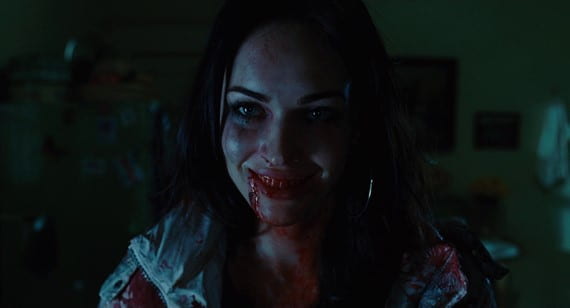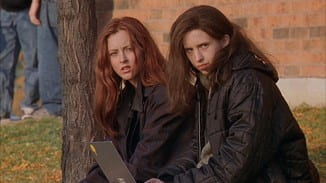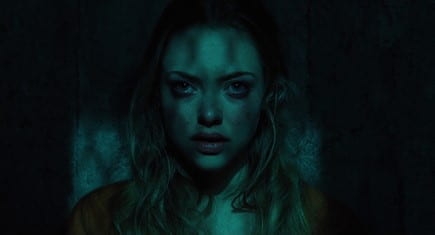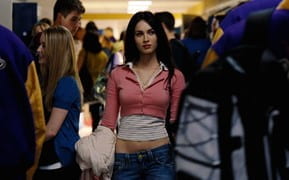
Several factors contributed to the box office underperformance of the Karyn Kusama-directed film Jennifer’s Body in 2009 — chief among them was the marketing, which relied heavily on selling the movie as a slasher with Megan Fox as the eye candy for a primarily male audience. Although the focal point of the film is the titular character and the havoc she wreaks upon the small, fictional town of Devil’s Kettle, Minnesota, the film is mainly from the perspective of Jennifer’s best friend, Needy (Amanda Seyfried), who was rarely featured as prominently in promotional materials. Reviews at the time gleefully ripped apart the film for having a simplistic plot and for being such a divergence from the career-high that was screenwriter Diablo Cody’s prior film, Juno. Rediscovered years later though as an underappreciated, feminist-bent horror film with social commentary on fame, it became a cult classic. It drew such a resurgence in interest that its ten-year anniversary produced a bevy of articles and interviews from the cast and crew reflecting on the making of the film. Due to this renewed visibility, the narrative around the film was refocused on the real central themes: the complexities of female friendship and female sexuality.
A large amount of the film’s introduction paints a picture of Jennifer and Needy’s friendship, with emphasis given to Jennifer’s popularity and Needy’s role on the sidelines in their high school’s hierarchy. Despite their different social statuses, they are childhood best friends with a bond that is unshakable, but there is tension between them in most scenes. There’s a mix of mutual love, resentment, and hatred underneath the surface during their interactions; it gives their friendship an authentic feel as we see them grappling to stay close and not acknowledge the ways they’ve outgrown each other. They can go from playfully joking around to Jennifer shoving Needy a little too hard or hitting her with a cutting remark during an innocuous exchange. Jennifer is often the aggressor in their confrontations, and the dominance she holds in the relationship seems to be an established part of their friendship until a power struggle between the two begins to occur in the second half of the film. The change in their relationship is incited after a horrible fire breaks out at a concert they attend; in the midst of the chaos Jennifer hitches a ride with the visiting band, Low Shoulder, who then ritualistically sacrifice her in a quest for fame. The band picks her out of the crowd due to the ritual calling for a virgin, but their assumption about her is incorrect and she subsequently becomes inhabited by a demon. The rest of the film follows Needy’s thinning resolve as she comes to the realization that she must kill Jennifer to save herself and the town.
The title of the film in some ways is a play on the under-arching feminist messages of the story. While it is true that after the sacrifice Jennifer’s body becomes the vessel for a demon, her body is all many people see when they look at her — her popularity seems reliant on it, too. Her body and her sexuality are tied together, and they form a sizable portion of her self-image. Even in her death she is not viewed as a teenage girl with dreams, passions, or a life to live; she is just a virgin deemed useful for the means of the all-male band’s ends. She lives her life as a sexual object and she dies objectified as well; the rebirth of sorts she experiences after her death gives her power, though, that she previously had no access to. Her body is now a façade used to lure in prey, exclusively young men, and many fall victim to her as soon as she shows even the smallest bit of interest in them. Few of her victims ever talk to her extensively before she attacks them, their prime objective being to possess her in some way, with the exception of Ahmet who is in the wrong place at the wrong time. Although Jennifer is possessed, her personality stays somewhat intact, which makes one wonder if her rampage of violence is a vengeance against the male objectification she experienced in her life. Her body in the end becomes just as scary as the monster it holds; she makes it into a tool instead of a burden she has to navigate. In this world, perceived or even expected ownership over girls and their sexuality is the norm, so a female character taking ownership of it herself is what everyone truly fears.
High school is a familiar backdrop for many a body horror or monster film because of an alchemy of factors. There’s the obvious comparison of bodies transfiguring aligning with puberty, but there’s also the perfect groundwork for massive character development. In every monster film there has to be a hero to save the people from the danger the monster poses. As young characters are growing and defining who they are and who they want to be as adults, a hero can be formed quickly due to the circumstances that call for them. While it might seem strange for children or minors to be the saviors in these films, it is explained in large part due to the inability of adults to recognize or even identify the potential danger to the student body. This seems to be an established trope of so many horror films, so much so that it feels only inevitable that the hero will be found amongst the students rather than the staff. This quality provides a sense of insularity and lawlessness — while there is perceived authority it’s not quite in control and so it truly is up to the students to save themselves. In some ways, it’s an all too relatable metaphor for life: you are independent, on your own, and it is up to you to save yourself.

While rewatching Jennifer’s Body, I was surprised to see similarities between it and the 2000 Canadian film Ginger Snaps, with the exception of the central monster being a teenage girl transitioning into a werewolf. In both films there is a female character trying to protect the monsters they are seeing come into creation. (For Ginger Snaps this role is filled by the sister, Brigitte.) Also in both, the promiscuity of the female character inhabited by a monster leads to a rise in status and popularity amongst boys within their school and their bloodlust, brutality, and volatility does little to scare away the males. There’s a bigger message in that, the fact that these evil characters find themselves with sudden or sustained attention amongst the high school population. Popularity helps lead victims to both monsters, and in Jennifer’s case helps to obfuscate her crimes, but other than that popularity truly doesn’t mean anything substantive about either girl. It’s a flimsy excuse to look the other way and if we can truly take high school again as a metaphor for life, popularity is a taste of what fame is in the real world.
With that comparison I need to note that Jennifer’s Body also dives so well into the fickleness of fame and the echoes of popularity within it. Needy becomes infamous due to her killing Jennifer while Low Shoulder does achieve widespread success and fame. In the end the teen girl is the scapegoat and is seen as the monstrous murderer even though her actions saved people and the band’s were based only on their aspirations of fame. Fame in the film is tainted, impure, and the attainment of it doesn’t speak to goodness or kindness — it is just an abstraction others dream of in order to gain material pleasures. It is also empty and, in the end, Needy is able to repay the band for the destruction they caused to her life. Low Shoulder’s fame ultimately does not provide them with saving grace.
What is typical in a story of monsters and mayhem is a male figure that saves the town, but that figure is absent here, instead replaced by a female protagonist. Horror is the genre that relishes in the subversion of normal roles, and it does so by casting heroines where heroes are often seen, and making the pool of victims largely male. But alas, although the heroism is given entirely to female characters, the aftermath of their actions is quite bitter. The final fight and deaths lead to isolation for both and in Needy’s case the loss of everything as she is institutionalized. There is no neat, tidy triumph over evil. There is success over killing the monster but the story explores more gray areas than the typical monster fare. This isn’t a fantasy and it isn’t a moral story of light and darkness, Jennifer and Needy are placed firmly in the murky waters of reality.

In the final acts of both Ginger Snaps and Jennifer’s Body, Needy and Brigitte conclude that in order to save their towns they have to kill Jennifer and Ginger respectively. In their transformation from once-meek young girls to heroines, there is a death of innocence. It’s an essential part of their journey that marks a shift from adolescence to adulthood, with the symbolic severing of their childhood and past with the murders. The murders are emotionally heightened by the fact that with the death of this friendship and sisterhood, they are also killing a part of themselves. In both films the monsters transition back to the girls the characters once knew, forcing them to sit with the knowledge that they have killed someone that they once and still do love. Jennifer and Ginger were instigators, and while they could be domineering and overbearing there was a vitality and fire to them that Needy and Brigitte lacked. Through their relationship the fiery characters pulled them out of their meekness, taught them what confidence was, and gave them the recipe to become their own heroines. While sadness is evident in the ends that caused the means, there is still some relief at the conclusion of the fight, in both the discovery of their resilience and the end of a drawn-out childhood.
Jennifer’s Body packs a ton of duality in its 102-minute runtime and I’m thankful it has been given more consideration upon reflection in recent years. As thrilling and horrifying as it is, I’ve always viewed it as a tragedy. Needy may have gone on to marry her boyfriend Chip and she and Jennifer may have grown apart, but they all had futures beyond high school that were taken from them. One reading of the film could choose to see the ultimate culprit of the tale as ambition, but that lets the true villains off the hook in my opinion. The men from Low Shoulder doomed the town once they murdered Jennifer the night of the fire; they had no idea if their ritual would work yet they still sacrificed her without remorse. There are some gruesome deaths and terrifying body transformations, but the most gut-wrenching scene remains her murder and it still stands out amongst the rest of the film’s visuals. The intent of horror is to uncover dark truths and anxieties we hold but cannot face on our own, and that scene is so disturbing because it reveals the way we view teenage girls as expendable in our society. I think the main intent of the film, though, is to see beyond the gore and to consider Jennifer, even with her high kill count, as just a victim. What we discover so often in monster films is revealed here as well: the true monsters are the humans.
Jennifer’s Body will screen at IU Cinema on January 14 at 10 pm as part of the Not-Quite Midnights series.
For another analysis of Jennifer’s Body and Ginger Snaps, check out Laura Ivins’s 2020 video essay.

Noni Ford is a freelance writer based in the Midwest and a graduate of the Indiana University Media School. She’s worked in voice coordination, independent film, and literary management, and primarily writes film criticism and short stories.

